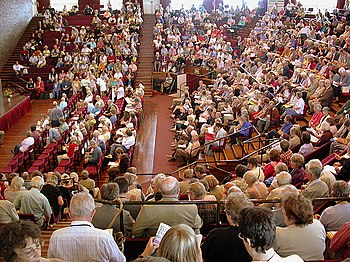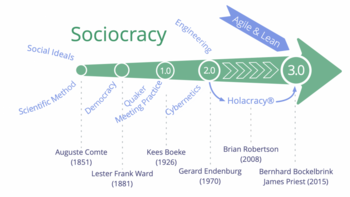User:Douginamug/Draft:Quaker decision-making


Quaker decision-making or Quaker Meeting Practice is a form of group decision-making used by Quakers (members of the Religious Society of Friends).
The practice is based upon the core Quaker belief that there is "God in every one"[1], and therefore every person has an equal and direct opportunity to experience the will of God. Subsequently, the practice aims to collectively discern the will of God through silent reflection, inspired statements and a capturing of the resultant "sense of the meeting".[2] The strong spiritual basis marks Quaker meeting practice as a mystical form of decision-making, in contrast to purely rational practices such as Parliamentary procedure. Quakers describe their practice as one of "unity", in comparison to majority, unanimity or consensus.[3]
Although minor differences between Quaker societies exist, the practice has not fundamentally changed since its conception in the late-17th century, shortly after Quakerism began.[4] The secular practices of Consensus decision-making in activist movements[5] and Consent within Sociocracy[6] were directly inspired by Quaker practice in the 21st century.
History[edit]
The Quakers were one of the many dissenting groups that separated from the Church of England during the English civil war. Their belief that every person has an equal and direct opportunity to experience the will of God put them at odds with the hierarchy of the established church. Numerous early Quakers individually interpreted the will of God to require acts of civil disobedience, such as refusing to take oaths, going nude in public and refusing to take off their hats in the services of the Church of England. The growing resentment of the establishment towards the Quakers peaked when James Nayler re-enacted Christ entering Jerusalem in Bristol, 1656. He was charged with blasphemy, mutilated and imprisoned; repression against other Quaker disobedience increased.
George Fox and others concerned for the continuation of the Quakers came to the conclusion that although God is present in every person, and although God is without contradiction, the interpretation of God's will is influenced by the person interpreting. Thus he encouraged believers to meet together and collectively interpret the will of God, to temper 'false' or extreme interpretations. Such meetings were not to be 'rational discussions', but rather a collective investigation into God's will through the combination of personal experience.[5][7]

Aspects of practice[edit]
Although the practice differs in detail between different Quaker organizations, the main aspects remain the same. The most regular Quaker meeting, Meeting for Worship, is exclusively for worship and does not use the practice. The practice is used for meetings in which Quaker affairs are investigated and decided upon; such meetings are generally referred to as Meetings for Church Affairs or Meetings for Business and include Area meetings and Yearly meetings. Meetings for Church Affairs are also considered to be meetings of worship, meaning "they carry the same expectation that God’s guidance can be discerned if we are truly listening together and to each other".[8]: 3.02
Clerk(s) and their duties[edit]
A necessary role in meetings is the Clerk. The clerk is responsible for preparing the meeting agenda, guiding the meeting, moderating if necessary and preparing minutes (i.e. transforming the 'sense of meeting' into written statements). The clerk is entrusted as a "servant of the meeting" not to abuse their influence over the meeting.[8]: 3.13
A person is appointed clerk by committee (which themselves have clerks), or by the parent meeting.[8]: 3.01 The clerk role may be shared between 2 or more co-clerks. The clerk, or co-clerks may have also have assistant clerks.

Silence and Speaking[edit]
Meetings begin with a period of extended silence, referred to as 'worship'. Attendees are expected to 'quiet themselves' and focus on 'the Inner Light'.[8]: 3.02 The Clerk then reads out the agenda in full, before introducing the first item.
Once an agenda item has been read out, the meeting silently reflects on the item. Individuals stand to speak if they feel moved to do so. Speakers are expected to make statements which are personal (based on their own experience), independent (not in response to other statements) and succinct; some meetings ask people to speak only once per item.
Silence is also observed after every speaker, to allow the meeting to consider the statements and return to a point of reflection. As such, dialogue does not occur in the normal sense. If necessary, the Clerk facilitates by encouraging quiet individuals to speak, reminding ones that are speaking at length to conclude, or asking for additional silence if tension emerges.[2]
Minute creation and conclusion[edit]
The Clerk uses their judgement to decide when an item has been fully examined, typically when they observe a period of extended silence. They then proceed to write a minute (written statement) which they believe discerns the 'spirit of the meeting' on that item, before reading it to the meeting. Individuals may then 'speak to the minute' in the same way of speaking as above, asking questions or making suggestions: the Clerk may edit or re-write a minute. The meeting must eventually 'unite in agreement' on a minute for it to be accepted, otherwise it is postponed. 'Unity in agreement' differs from unanimous agreement, since people may agree as part of the meeting against their personal or rational interests: it may be expressed through silence, or confirming statement.[8]: 3.15
The remaining items are dealt with in the same way until finished or the meeting runs out of time.
Meetings are concluded with another period of extended silence after which participants stand, shake hands and then often socialize.
Influence[edit]
The practice has been adapted for non-Quakers multiple times in the 21st century. Although there is debate on the viability of transferring the practice without the underlying belief systems[9][10], the variance of belief between Quakers, including the existence of Nontheist Quakers, suggests some flexibility.

Sociocracy[edit]
Cornelius 'Kees' Boeke was a Dutch Quaker who founded a Werkplaats Kindergemeenschap based on Quaker principles in 1926. It used a secularized version of Quaker decision-making in which the students would also participate in the running of the school. This went on to be developed by Gerard Endenburg (one of Boeke's students) in the late 1960s to become known as Consent within contemporary Sociocracy.[6]
Women Strike for Peace[edit]
Eleanor Garst was greatly influenced by Quakerism when her husband received unasked-for support from Pennsylvanian Quakers of the War Resisters League for resisting conscription into WWII. Eleanor is accredited with introducing Quaker-style meeting practices to the founding meeting of Women Strike for Peace in 1961.[11][12] It caught on, and in time became referred to as Consensus, with the emphasis on silence eventually being abandoned.
See also[edit]
- Quakers
- Monthly meeting
- Yearly meeting
- Clerk (Quaker)
- Book of Discipline (Quaker)
- Sociocracy
- Consensus
References[edit]
- ^ Fox, George (1903). George Fox's Journal. University of Michigan. London, Isbister and company, limited. pp. 215–216.
"This is the word of the Lord God to you all ... be patterns, be examples in all your countries, places, islands, nations, wherever you come ... then you will come to walk cheerfully over the world, answering that of God in every one
- ^ a b "Quaker Business Meetings". Quakers in Scotland. 2007-03-05. Retrieved 2020-09-11.
- ^ Morley, Barry (1993). Beyond Consensus: Salvaging Sense of the Meeting. Pendle Hill. p. 5. ISBN 978-0-87574-307-3.
Through consensus we decide it; through sense of the meeting we turn it over, allowing it to be decided. "Reaching consensus is a secular process," says a Friend. "In sense of the meeting God gets a voice."
- ^ Burrough, Edward (1834). Howard, Luke (ed.). "A Testimony concerning the beginning of the work of the Lord... [1662]". The Yorkshireman, A Religious and Literary Journal by a Friend. 2 (XXVI). London, Longman and co., Paternoster Row: 137–138. Retrieved 8 September 2020.
And to determine of things by a general mutual concord, in assenting together as one man, in the spirit of truth and equity, and by the authority thereof, in this way and spirit all things are to be amongst you, and without perverseness in any self-separation, in discord and partiality.
- ^ a b Blunden, Andy (2017). The Origins of Collective Decision Making (1 ed.). Chicago: Haymarket Books. p. 8. ISBN 978-1-60846-804-1.
- ^ a b Boeke, Kees (1945). "Sociocracy: Democracy as It Might Be". Retrieved 2020-09-02.
When I began to hold these talkovers, I was aware that I was using the procedure of the Quaker business meeting, and I saw in the distance, as it were, the great problem of the government of humanity.
{{cite web}}: CS1 maint: url-status (link) - ^ Hill, Christopher (1991). The world turned upside down : radical ideas during the English Revolution. London. ISBN 0-14-013732-7. OCLC 26371856.
{{cite book}}: CS1 maint: location missing publisher (link) - ^ a b c d e Quaker faith & practice : the book of Christian discipline of the Yearly Meeting of the Religious Society of Friends (Quakers) in Britain. Library of the Society of Friends (London Yearly Meeting) (5th ed.). 2013. ISBN 978-1-907123-54-2. OCLC 869000016.
{{cite book}}: CS1 maint: others (link) - ^ Muers, Rachel; Burton, Nicholas (2019-11-01). "Can We Take the Religion out of Religious Decision-Making? The Case of Quaker Business Method". Philosophy of Management. 18 (3): 363–374. doi:10.1007/s40926-018-0095-0. ISSN 2052-9597.
- ^ Kauffman, L.A. (2015). "The Theology of Consensus". jacobinmag.com. Retrieved 2020-09-12.
- ^ "Mary E. King » The short and the long of creating democracy". 2011. Retrieved 2020-09-11.
- ^ Swerdlow, Amy (1993-11-15). Women Strike for Peace: Traditional Motherhood and Radical Politics in the 1960s. University of Chicago Press. ISBN 978-0-226-78636-0.
